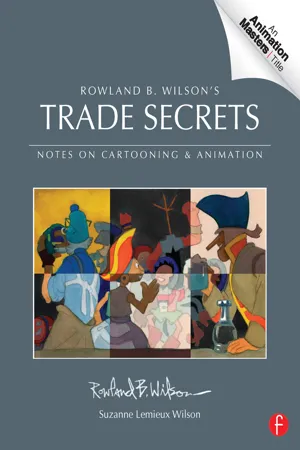![]()
1
THE ACT
Reproduced by Special Permission of Playboy magazine.
Copyright © 1968 by Playboy.
Story: A cause and effect (plot!) series of linked events told (exposition: everything is exposition!) in an uncertain or unpredictable way (suspense, forward motion, foreshadowing, dramatic irony, surprise) intended to involve the audience (empathy, subjectivity!) with the characters to the end (forward motion!) and make a satisfying statement (and statements along the way: the author’s viewpoint can’t be wholly explored in one end-theme) on life. The thematic statement X leads to Y.
Told how? With words expressed by characters and pictures that show the situations: what, where, when, and how (—and why!—).
Story
It’s all about “Story”! This is the heart and the nucleus of the work from which the visualization springs. Whether it is a script, a book, opera, cartoon, game, commercial or illustration—this is your springboard. The act is the basic unit of the story or script and often you will find more than one act. The artist’s job is to translate from written word to the pictorial.
The script is the “written half” and answers the “what,” “why,” “how” and “who.” It contains the plot, exposition or sequence of events, suspense, forward motion, foreshadowing, dramatic irony, surprise and characters. There is usually an overall theme and short themes. The “picture half” is continuity and comprises a number of elements. Character design is akin to actors and acting—who are they and how do they embody the story? Locale illustrates the “where” of the action and often creates and enhances the dramatic mood. Action can be comic, dramatic, entertaining or adventure. Plot themes are the “And then…” of the story, moving along to the next scene.
An additional consideration is the audience point of view. It is important for manipulation of subjective effects, suspense, and empathy in characters and events.
Storytelling: The Point of View
Where To Put Time Camera?
We the audience have to be somewhere in order to see and hear the story.
Sometimes we can hear but not see or see but not hear… for some story reason.
Amateur storytelling puts the camera (audience) in some silly or cute place that draws attention to itself or conversely always puts the audience in the same place regardless.
When you position the audience to look at a scene, imagine you are there. How would you be there? In what capacity?
Would you look down omnipotently?
Look up like a mouse?
Would you be in close like a participant?
Would you be hiding like a voyeur?
Would you be a passerby?
Are you sitting or standing?
Or flying?
Are you short or tall?
Are you one of the characters?
If so, what would you notice?
Why do the good directors put the audience where they do? Always consider if there could be more effective camera/audience work.
The Aspects of Pictorial Storytelling
Subject Matter
1. Genre: The type of story: Romantic Comedy, Drama, Western, Science Fiction, etc.
2. Characters: The performers.
3. Plot: Such as competition for the desired object.
4. Theme: For example: Metaphor, Power, Personal Aggrandizement, Pride, Love.
5. Style: Farce, Operatic, Slapstick and others. (Farce is said to be derived from the word for stuffing… can it be styled in the sense of “stuffed” or “over-overstuffed”?)
Chain of Event
1. Linked together actions written out.
2. Dialogue written into script.
3. Visuals: Main themes of each section indicated as thumbnails establishing atmosphere, look, style.
4. Pacing: Variations and development.
Story Rendition
(Actions, dialogue and visuals woven together by continuities with focal points.)
1. Focal points and themes determined by examination.
2. The Unfolding: Shots and continuities chosen for theme and focus from the diagrams.
Story Themes
(Story themes run from the largest to the intermediate down to the specific.)
1. Overall: The “Grand Scheme.” What is the over-riding concept, philosophy and totality? (Described in a few words or single sentence.)
2. General: Comedy, Suspense, and Action.
3. Specific:
A. Attitudinal such as vindictive, superiority complexes, bluster, greed.
B. Atmospheric: the mystic sea, outer space.
C. Contradictions, such as false love and true love; flawed people in action.
4. Character: Display of personality.
5. Plot: Goals.
Story Focal Points
1. Revelations.
2. Turning Points.
3. Emotional acts and effects.
Story Focus
1. Story Focus means: “The point is this.”
2. Story Focus changes as you go through the story. It can be long or short. (Pages or a panel.)
3. Story Focus can be cross cut:
A. For contrast: Dramatic irony or comic effect.
B. For suspense: Converging with danger; converging with relief.
4. Story Focus can be examined. It should answer the questions:
A. What is happening?
B. What is the most important aspect of what is happening?
C. What is the most satisfying way to show the most important aspect?
i. Is it more satisfying to show the story focus ...





